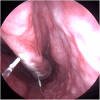Office-Based Blue Laser Versus Coblation Therapy for Inferior Turbinate Hypertrophy: A Pilot Study
- PMID: 40370997
- PMCID: PMC12076342
- DOI: 10.1002/oto2.70127
Office-Based Blue Laser Versus Coblation Therapy for Inferior Turbinate Hypertrophy: A Pilot Study
Abstract
Objective: The aim of this pilot study is to compare the effectiveness of office-based blue laser therapy with coblation therapy in patients with inferior turbinate hypertrophy (ITH).
Study design: Retrospective chart review.
Setting: Tertiary referral center.
Methods: Patients presenting with nasal obstruction between November 2022 and November 2024, and underwent coblation or blue laser therapy for turbinate reduction were reviewed. Demographic data included age, gender, smoking, history of allergy, history of reflux disease, and history of prior nasal surgery. All patients had filled the nasal obstruction symptom evaluation (NOSE) questionnaire and the visual analog scale (VAS) before and on follow-up after treatment. Patient's level of comfort during the procedure was also rated using a 10-point Likert scale with a higher score indicating a greater level of comfort.
Results: A total of 10 patients underwent office-based blue laser therapy for turbinate reduction, and 10 patients underwent office-based coblation of the inferior turbinates. In the subgroup of patients who underwent office-based blue laser therapy, the mean NOSE score and VAS score decreased significantly (P = .005). In the subgroup of patients who underwent coblation, the mean NOSE score and VAS score decreased significantly (P = .005). When comparing the two subgroups, the difference in the drop of the NOSE score was not statistically significant (P = .198). Similarly, the difference in the drop of VAS score was not statistically significant (P = .280).
Conclusion: The results of this investigation indicate that both coblation therapy and blue laser therapy are effective office-based treatment modalities in patients with ITH with comparable results.
Keywords: blue laser; coblation; inferior turbinate hypertrophy; nasal obstruction; office‐based.
© 2025 The Author(s). OTO Open published by Wiley Periodicals LLC on behalf of American Academy of Otolaryngology–Head and Neck Surgery Foundation.
Conflict of interest statement
The authors declare that there is no conflict of interest.
Figures


Similar articles
-
Office-based blue laser therapy for inferior turbinate hypertrophy: a pilot study.Eur Arch Otorhinolaryngol. 2024 Oct;281(10):5357-5361. doi: 10.1007/s00405-024-08781-z. Epub 2024 Jun 25. Eur Arch Otorhinolaryngol. 2024. PMID: 38916744
-
High-Intensity Focused Ultrasound Therapy Versus Coblation for the Treatment of Inferior Turbinate Hypertrophy: A Clinical Trial.Clin Exp Otorhinolaryngol. 2023 May;16(2):141-147. doi: 10.21053/ceo.2022.01312. Epub 2023 Feb 13. Clin Exp Otorhinolaryngol. 2023. PMID: 36791808 Free PMC article.
-
Radiofrequency Coblation Versus Intramural Bipolar Cautery for the Treatment of Inferior Turbinate Hypertrophy.Ann Otol Rhinol Laryngol. 2015 Sep;124(9):691-7. doi: 10.1177/0003489415578709. Epub 2015 Mar 31. Ann Otol Rhinol Laryngol. 2015. PMID: 25827133
-
Surgical Management of Inferior Turbinate Hypertrophy in the Era of Widespread Communicable Disease.Cureus. 2023 Jan 27;15(1):e34280. doi: 10.7759/cureus.34280. eCollection 2023 Jan. Cureus. 2023. PMID: 36855496 Free PMC article. Review.
-
Surgical Management of Turbinate Hypertrophy.Otolaryngol Clin North Am. 2018 Oct;51(5):919-928. doi: 10.1016/j.otc.2018.05.008. Epub 2018 Jul 18. Otolaryngol Clin North Am. 2018. PMID: 30029923 Review.
References
LinkOut - more resources
Full Text Sources

